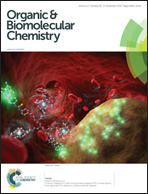A design strategy for small molecule-based targeted MRI contrast agents: their application for detection of atherosclerotic plaques†
Abstract
Gadolinium(III) ion (Gd3+) complexes are widely used as contrast agents in magnetic resonance imaging (MRI), and many attempts have been made to couple them to sensor moieties in order to visualize biological phenomena of interest inside the body. However, the low sensitivity of MRI has made it difficult to develop practical MRI contrast agents for in vivo imaging. We hypothesized that practical MRI contrast agents could be designed by targeting a specific biological environment, rather than a specific protein such as a receptor. To test this idea, we designed and synthesized a Gd3+-based MRI contrast agent, 2BDP3Gd, for visualizing atherosclerotic plaques by linking the Gd3+-complex to the lipophilic fluorophore BODIPY to stain lipid-rich environments. We found that 2BDP3Gd was selectively accumulated into lipid droplets of adipocytes at the cellular level. Atherosclerotic plaques in the aorta of Watanabe heritable hyperlipidemic (WHHL) rabbits were clearly visualized in T1-weighted MR images after intravenous injection of 2BDP3Gdin vivo.


 Please wait while we load your content...
Please wait while we load your content...